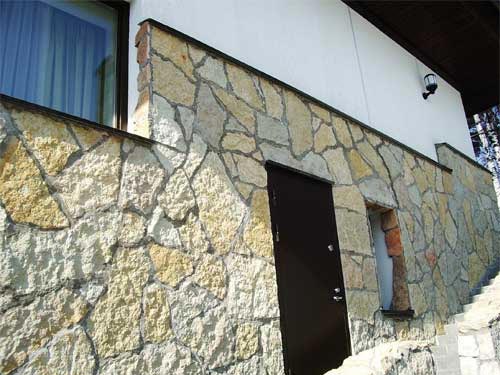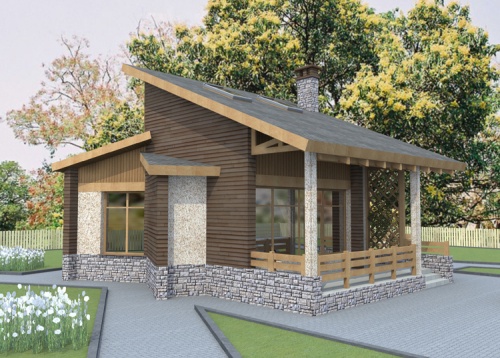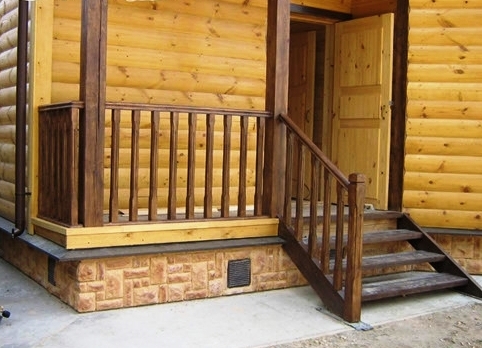The desire to make your home not only reliable and convenient housing, but also beautiful is inherent in everyone. One of the final construction - decorative trim cap. It is not distinguished by a special practical value, but it certainly has a distinct aesthetic character.
Content
What to do facing the cap?
Of all the ways of today is especially interesting and attractive looks of the exterior design of the foundation stone.
No matter what type of material is chosen, the foundation stone finish always gives solidity and elegance of the house.
There are two major categories of stone:
Natural stone is always in demand for finishing the base, despite the high cost, due to its eternal strength and natural origin.
Important! By choosing this material, keep in mind that will require significant costs not only for its purchase, but also for transportation. Moreover, natural stone finishing foundation entail additional costs rather laborious process to enhance its outer part.
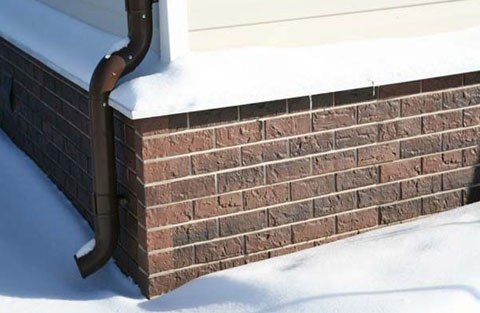
Why artificial stone practical?
An excellent alternative, gradually displacing natural stone, has become an artificial substitute. In our country, in the market, he appeared relatively recently, about 10 years, but once firmly established its position.
Not falling interest in it provided a number of advantages:
- light weight, which removes any restrictions to the type
- strength, which ensures long-lasting operation
- easy installation on any surface
- appearance, fully repeating texture and shade of natural stone
- a much larger variety of shapes and colors to solve any design ideas
- components naturalness.
Important! Separately, we note that the price is finishing the foundation stone for much lower and more affordable than the cost of the same works made from natural materials.

What is an artificial stone?
artificial stone production takes place on two technologies:
- gypsum-based
- based on Portland cement.
The additives used sand, marble chips and fillers to increase strength, absorption of moisture, cold resistance, weight reduction. A solution prepared by adding water in the correct proportions.
Important! Both types of stone quite able to make your own at home using a molding, for example, silicone templates. Enough to buy all the ingredients to mix exactly the recipe, fill in the form and wait for complete hardening. Visual confirmation - a photo finish foundation stone of a material prepared with their own hands.
How to perform a plinth facing on their own?
- Design.
- Selection of technology.
- Selection of material.
- Preparing tools.
- Preparation of the surface to be tiled basement.
- Laying of stone.
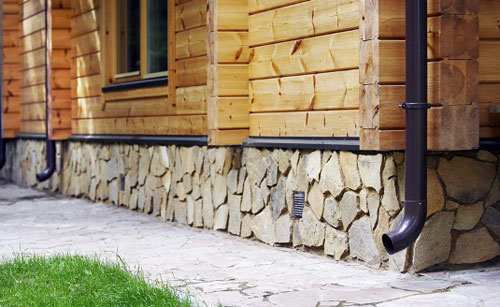
design design
In the process of artistic planning, you will first consider carefully a photo of the foundation of a stone in various versions. Pick up the most attractive ideas and place yourself in a suitable sequence.
Complete the amount of the required material, given the parameters of the surface of the foundation, the dimensions of the fractions selected by the laying technology and the allowable overrun of about 10%.
How to choose laying technology?
There are two ways of cladding:
- seamless

- with the seams.

Important! Make a choice of more appropriate technology yourself, taking into account the features of the project. But be sure to take into account the case of the material during the design of the seams, the flow rate is smaller than when laying the jack.
What to pay attention to when choosing an artificial stone?
When buying a material, be sure to pay attention to the quality of products by defining it according to the following criteria:
- Dimensions. For finishing the foundation for the stone, boulders are very attractive, the material in the form of small plates with the cornerstone multifaceted incorrect form is an option to create a more powerful masonry under the wild stone.

- Appearance. Given the goal to create a natural stone imitation, it is worth considering that in nature it is difficult to find the same shade and the form of two fragments. Therefore, carefully look at the artificial stones of one collection. They must also be diverse and in form, and in color to eliminate the frequent repetition. That is, than a variety of presented a number, the harder to identify the imitation of the stone on the finished surface.

- The quality of the surface of the stone. On the front surface should not be growths and uncharacteristic for stone irregularities. The back side must be a measure of rough to ensure reliable clutch with the surface on which the masonry is performed.

- Sizes of filler fragments. All grains in the body of the stone should not exceed 5 mm, otherwise the strength will not match the specified, and the likelihood of cracks and crumbling is great. Consider close several parts of the collapsed collection fragment to determine the location of the fillers.

- Method of painting. Give preference to boulders, with a fully painted mass. Otherwise, when chips appears, the inside of the material differs in color.

- Manufacturer. If possible, give preference to domestic brands. Our manufacturers make stones more adapted to our climatic conditions that do not require additional processing.

- Form configuration. Learn in advance the principle of packaging. To preserve integrity and provide convenient transportation, the best option is comfortable, dense boxes.

Tool preparation
To fulfill all the work on finishing the foundation of the house under the stone in advance, take care of the tools and consumables.
Focus on the following list:
- Saw
- Level
- Waste or cord
- Spatulas (gear and smooth)
- Metal brush
- Primer
- Putty
- Put
- Glue
- Rollers
- 1-2m long line
- Sandpaper
- File
- Drill or perforator
- Pistol for filling seams
- The blade for grouting seams width of 6-8 mm.

How to choose suitable glue?
Carefully reinfeit to the selection of a suitable adhesive composition. Note the following selection nuances:
- Pay attention to special formulations for external work.
- Consider facing features, the type of stone and the need for a good clutch for a long time under the influence of various destructive factors (water, sun, frost).
- Focus on verified manufacturers of high-quality compounds from the list below:
- Ceresit.
- Getacore.
- Unice Plus
- Corian.
- Plitonit.
- Litokol
- Fastener
- Montelli.
- Confiad.
- Opal
- Coral
Preparation of the surface of the foundation
The volume of preparatory work is small, mainly depends on the state of the surface.
Most often, the base material is brick or concrete, which have a similar composition and the same properties as an artificial stone. Therefore, the initial conditions of adhesion are high enough.
The principle of processing the base of the base is as follows:
- Carefully clean the surface with spatulas and metal brush.
- In the presence of cracks or chips - zashpatlyuyte.
- Reinstall all irregularities in places of repair.
- Make sure the surface of the base is dry.
- Scroll.
- Wait for drying.

Laying of stone
Start operation for finishing artificial stone foundation only after all preparatory processes to dry, preferably warm weather.
Be sure to follow these guidelines for placement technologies:
- Draw the line and the bottom line the upper decorative layer.
- Make provisional layout on the surface, e.g., by means of cord or beacons.
- Draw the line especially careful when laying the surface in neat rows, not asymmetry.
- On the pavement near where the cladding made a string of stones laying open position.

Important! Make sure that the resulting image fits your expectations. Pay heed to the combination of shapes and colors fragments adjacent. Find a new solution in places where you do not like the sequence.
- Read carefully the instructions on the pack glue for its preparation.
Important! Pay attention to the drying time to take it into account when laying.
- Prepare a solution of exactly soaking formulation.
- Apply the adhesive to the wall or directly with the fragments of the lining material.
Important! When applying the solution onto the surface of the base, limits the area of \u200b\u200b1 meter. This is to prevent premature drying of the adhesive.
- Start packing with the bottom row of the corner of the building.

Important! This principle helps to avoid slipping stones and sustain lines evenness.

- Focus on the prepared layout.

- Elements are pressed into the adhesive material on the foundation or pressed down tight against the wall of the substrate solution directly on the stone.

- When used with the jointing technology leave gaps between joints bonded in boulders 1.5-3.5 cm (select the appropriate size, based on the size of the fragments).

- Make sawing parts to install incomplete components.
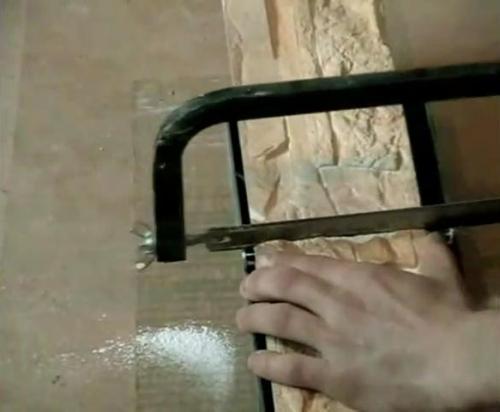
- Smooth out all the edges cut with a file or sandpaper.
- Prime with the solution used for the surface preparation of the foundation.
- If necessary, trim the edges on the individual stones glued to designed pattern was more attractive.
- Fill in any gaps with glue or specially trained troweling mortar.

Important! Fill the seams very carefully to eliminate the composition of the stone itself.
- Wait for drying within 24 hours.
- Perform the decorative grout of the seams.

- If necessary, treat the surface with a hydrophobic composition.
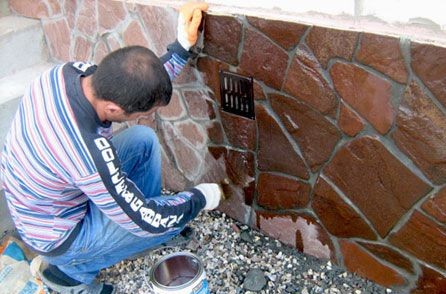
Important! When buying pay attention to the properties: it should not form a film and prevent the absorption of moisture.
Video
Watch a video of finishing technology foundation stone.
Conclusion
Facing the outside of the foundation of a decorative stone not only guaranteed to make more interesting the whole look of the house, but also protect from destruction. Stick to the rules of technology in all the work and the result of which will certainly please you, do not take long.




